I’m kind of a safety nut… having bumped my head on more than one occasion while mountain biking, been sideswiped and turned into by cars, and knocked out twice on my snowboard; so helmets are basically a requirement. Absorbing hard impact should really be a last resort though, right?! If you can ride safely and be seen by cars, avoiding impacts altogether, that would be ideal. And this is exactly what the Lumos helmet aims to do. It’s a smart bicycle helmet that keeps you visible with a total of 48 embedded LED lights that can be activated as solid, slow-flashing, or fast-flashing while also enabling you to communicate your navigation intentions to fellow cyclists, motorists, and pedestrians through the use of yellow blinking turn signals. And, because all of these LED’s are positioned up high, on your head, they are much more likely to be seen by drivers and less likely to be blocked by clothing, bags, and other gear mounted to your bike frame. Frankly, I think it’s an amazing product… but there are some trade-offs to consider.
Priced at $199, this is a very expensive helmet. Compared to my $70 Specialized Echelon II helmet (which doesn’t have any lights or extra features, just reflective stickers) this thing is basically 3x the cost! Occasionally, it seems that the Lumos helmets go on sale for $169 through their website, but even that is fairly pricy. And, the helmet weighs more than most non-smart helmets. My Echelon II is ~0.8 lbs and while visiting a shop called Propel Bikes in Brooklyn, NY I was able to weigh a bunch of other designs that ranged from 0.7 lbs to 0.9 lbs depending on coverage, branding, and visor attachments. The Lumos helmet, by comparison, weighs almost exactly one full pound and does not appear to have any sort of visor or warmth accessories like ear protectors. The helmet space has been evolving in recent years with products like the SENA helmet that has integrated speakers that can transmit your music, phone calls, and turn-by-turn GPS from a smartphone and the Specialized Centro LED helmet which is lightweight and cheap but only has one small LED light on the back. The Lumos is the brightest, possibly safest helmet I have come across, and the lights are covered by smooth, clear plastic strips that should keep dust and water out… it’s really professional despite debuting on Kickstarter in 2015 and remaining mostly unchanged for all of these years.
Since being launched, the Lumos Kickstart edition helmet has won a Eurobike Gold award in 2016 and a Red Dot design award in 2017. It has gone from being sold exclusively on Kickstarter to their own official website and now appears in some bicycle shops where you can touch and try it on. It looks like Amazon also carries the helmet direct from Lumos. The shop I visited, Propel, had several colors to look at, which was fun for the video review. And the owner, Chris Nolte, told me that he had sold several units to local customers who were very happy with them. The helmet has an embedded rechargeable battery that you can fill with a little USB dongle and the same goes for the remote button pad with a rubberized L and R touch point. Once the helmet and dongle have been charged, you simply turn on the helmet by pressing a rubber button on the back (and you can keep pressing to cycle through the three modes: solid, slow flash, quick flash) and then hold either the Left or Right buttons on the controller unit to activate the turn signal feature. It appears that you do have to hold the button for a moment vs. just pressing it, but then it stays lit so you know that the turn signal is still going. You have to actively hold again to turn off the signal. It’s very simple and compact, but would still add some clutter and distraction to your basic cycling experience. It looks like the button pad and helmet communicate over a radio signal, and I’m guessing they went with something short-range to save power and avoid interference. The handlebar remote is removable, just twist and pull off, so you can keep it from getting stolen or bumped at the bike rack, but replacements are only $29 if something unfortunate does happen. Same goes for the charging cable, for ~$13 you can get a replacement or additional cable to charge both the helmet and remote simultaneously. I like that they went with standard USB Type A plugs and have a magnetic interface on the helmet and remote without any deep groves or rubber flaps to get dirty or pulled off. I cannot say for sure, but it seemed like both the helmet and button pad contain rechargeable Lithium-ion batteries which cannot be replaced. The helmet doesn’t have any sort of door or flap to show you where the battery is located, and even though there are screw holes on the control pad, I’m not sure where to get replaceable rechargeable batteries this small if you were to open it up. So, that’s a bit of a bummer, but Lumos has said that after the 2 to 3 years of use that you can expect to get from the stock batteries, it might be time to replace your helmet anyway. To maximize the life of Lithium-ion cells, I have heard that storing in a cool dry location is best, and that you can leave them at ~50% full for longer periods of disuse.
Aside from the standard lights and turn signal features that this helmet offers, there is also a bright brake light mode which is triggered by hard stops. After a bit of experimentation, Chris and I could not figure out how to work it and were not able to confirm where the accelerometer is placed but it seems like you need to pair the system with your smartphone and engage this feature in the settings, the sensor unit may be built into the button pad. Ultimately, I’m not sure it’s a necessary feature, and I’d rather keep the helmet as lightweight and affordable as possible, so their externalized integration makes sense but it just wasn’t super clear in the instructions how to enable all of this, at least for us. At the end of the day, I think this helmet looks cool but not super cool. The colored plastic shell wraps all the way down and around the base vs. going to black foam like my stock helmet. This made it look like an upside down boat on my head, and while it probably adds to the durability and water resistance, I do care about style and hope that they continue their design experimentation as time goes on. The bright yellow and green would be visible and noticeable during the day but I would probably get white to help it match my gear and not look quite so dorky. Yeah, I’d rather be a dork who is alive… but with all of those LED’s going, I feel like this is still going to be one of the most noticeable helmets around, regardless of the color you choose, as long as you leave it turned on ;)
The Lumos helmet came double boxed for protection and possibly to deter theft. It’s a bit wasteful, but hopefully you can recycle cardboard where you’re at. It slides out nicely when opened and all of the accessories (mount, button pad, charging cable) are stored in a little box under the helmet. Just twist the button pad to release it from the cardboard. I like how adjustable the webbing straps are on the helmet and that there are two reflective stickers on the back portion of the adjustable crown, which extend down. This little addition should keep the back of your head visible even if you’re looking down and seated more aggressively, forward-leaning. I hope Lumos continues to refine their helmet design, I would love something that looked just like my Echelon II that also had these integrated lights, weighed a bit less, and maybe cost $150 vs. $200. I cannot comment on ventilation, unfortunately, but the helmet does have big holes between the plastic arms that should let air pass through and the protective bits extend way down on the back, offering good rear and side impact coverage. This helmet is certified in both Europe and the United States for riders 5 and above. In total, it has 48 LED lights embedded with 16 positioned in a triangle back (defaulted to red), 10 in the front (defaulted to white), and 11 along each side (defaulted orange when turning and red with the accelerometer stop feature active). If you’re ordering online, it’s worth checking the fit, but I’d say their range is good and comfortable, and more long than round like some other helmets I have tried. I’m a white European guy with German and Scandinavian roots and it feels good to me :)
UPDATE! A commentor on YouTube shared the following about the brake light: “I have this helmet, you need to update the software by pairing it with the Lumos smartphone app and then turn on the safety warning mode for the helmet. The accelerometer is in the wireless button pad, not in their helmet, when activated it will engage all of the red lights in the rear triangle and side turn signal triangles when you come to a stop.”
Pros:
- This helmet was launched on Kickstarter in 2015 and raised nearly one-million dollars with over six-thousand backers! considering it’s a crowdfunded project, I thought the product was very polished and professional
- It’s available in six sporty colors including the satin Pearl White and satin Charcoal Black or glossy Electric Lime, Lumos Yellow, and Cobalt Blue so you can match your gear or differentiate yourself from friends and family
- It won the coveted Red Dot design award in 2017 in the bicycles and bicycle accessories category, Red Dot is an international product design prize awarded by the Design Zentrum Nordrhein Westfalen in Essen, Germany – it also won the Eurobike Gold Award in 2016
- Both the helmet and wireless button pad appear to be well sealed against water and Chris said he has not had any problems with it on rainy days in New York City, and that his customers have been happy with it too
- My traditional non-lighted helmet from Specialized (the Echelon II) weighs ~0.8 lbs and most of Chris’s brand new helmets weighed ~0.7 to 0.9 lbs but the Lumos (with its internal battery and lights) only weighed ~1 lb which seemed pretty reasonable to me
- I love how Lumos almost went overboard with the number of LED lights they embedded on their helmet, it’s way more visible than most of the competition, especially the Specialized Centro LED that I reviewed a while back
- Unlike a lot of the frame-mounted bicycle lights, the Lumos positions lights way up high which are going to be more visible and they won’t get blocked by any rack bags or a long coat you might be wearing, I also like that the turn signals and rear light blink to create more awareness vs. always being steady on
- You do pay more for this helmet, my standard Specialized Echelon II was $70 whereas the Lumos is $199 occasionally on sale for $169
- Lumos is unique in that it sells direct through a website but is also partnering with bicycle shops across the US so you can see and test it in person before making a purchase
- I think they did an excellent job with the turn signal feature because it uses most of the lights points and shows on both the front and back of the helmet, it’s not some tiny thing that will be easily missed
- It’s neat that they put reflective stickers on the back part of the plastic crown, every little bit helps and this would have been easy to skip but it definitely makes the visual footprint taller and would be useful if you’re bent forward and looking down in a more aggressive body position
- This helmet complies with the United States CPSC safety standard for bicycle helmets for riders age five and older and with European CE EN1078 safety code
- The control button pad can be twisted to remove from the handlebar of your bike when parked, in this way it might stay cleaner and not be tampered with or get stolen
- You charge the button pad and helmet with a standard USB Type A dongle with a magnetic 4-pin plug, it works well and should be easy to plug in to your computer or power strips, it’s a very simple and universal charger that is super small and lightweight… just don’t lose the dongle!
- Lumos does sell additional helmet padding, replacement charger cables and button pads, even the button remote mount with the rubber bands in case you lose them and the prices are reasonable on their official website here
Cons:
- The battery that powers the LED lights on the helmet is rechargeable but not replaceable, over time this battery will degrade and eventually limit how long the helmet will stay charged (store it in a cool, dry location to maximize life and at ~50% if you know you aren’t going to use it for a long period of time)
- Minor consideration here, the helmet only comes in one size but the crown is very adjustable, it should fit head sizes (54 – 62cm / 21.3 – 24.4in) which worked for both Chris and I, it didn’t fall off once I tightened it even though I hadn’t buckled the strap and bent over forward
- Even though Lumos advertises a motion sensing brake light, I believe you need to engage this with your smartphone app first, it sounds like the accelerometer is built into the button pad so at least you don’t need to run your phone while riding
- I personally do not think this helmet looks as cool as my Specialized Echelon II because the colorized plastic wraps all the way down vs. going into black foam or just having some contrast, however it’s still one of the cooler lighted helmets I have seen and this comes down to personal taste I suppose
- Even though this helmet is fairly light for what it offers (the LED’s and integrated battery) the added weight could give you a neck ache if you ride in a more aggressive-forward body position or go over lots of bumps, my neck is pretty sensitive from car accidents and sports injuries so I like to keep my helmets as light as possible
- Some bicycle helmets now have mesh built into the front vents to keep bugs from getting caught in your hair, this is especially useful if you’re allergic to bees and other stinging insects
Resources:
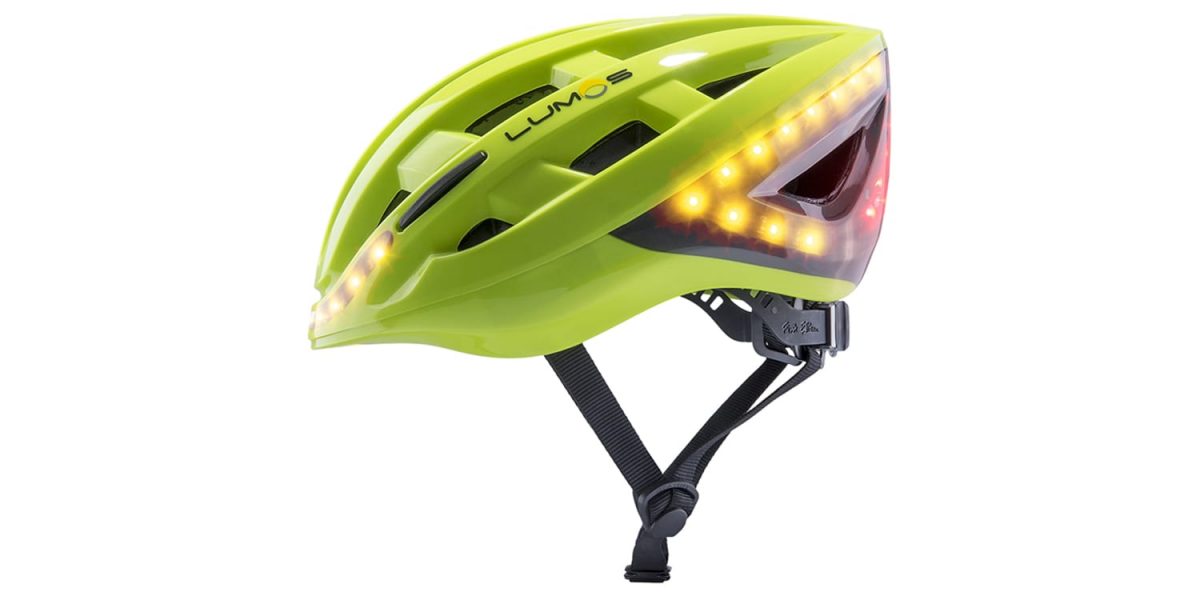








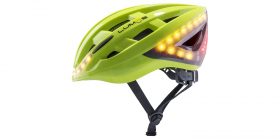
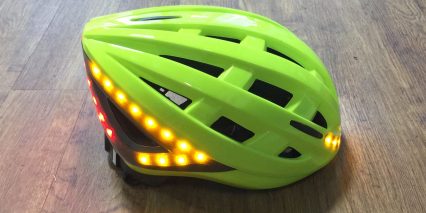
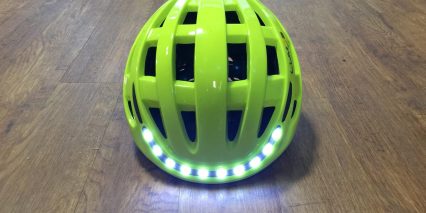


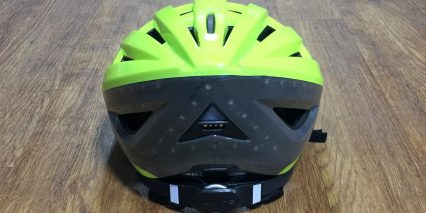
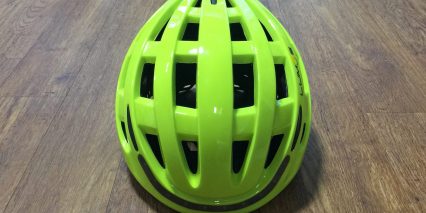
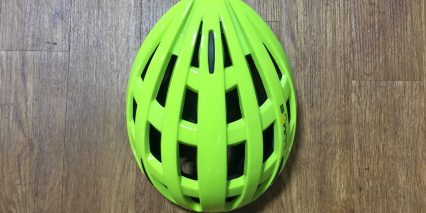
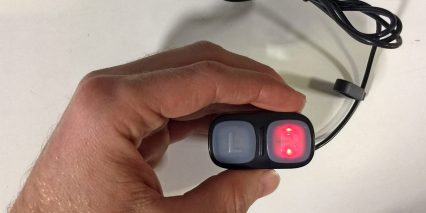

Aron
7 years agoThe Torch helmet seems to be $120 on amazon now. Anybody know how it compares?
ReplyCourt Rye
7 years agoNice! I haven’t tested that one as thoroughly but get the impression that it’s a simpler light without turn signals and that it might be heavier but has this BMX or skateboard type of styling vs. the aerodynamic cyclist styling. I’d love to hear your thoughts if you go for this Aron!
ReplyJohn J. De Tuerk, Jr.
7 years agoI’m on my second Lumos helmet. The first one was toast after an over the bars crash landed me on my head. I have no memory of the crash, and after a five hour stay at the hospital emergency room returned home with a sore left groin pull. I wear my helmet every time I ride and have all three of my bikes set up with the turn buttons on the bars. I charge the helmet after each ride (I ride between 30 & 50 mi /day, weather permitting). The helmet works flawlessly. I don’t ride without my Lumos helmet, my Cygolite HotShot Pro binkey, My Cycliq rear camera. and my Garmin Varia radar unit.
ReplyCourt Rye
7 years agoGreat testimonial John! I’m so glad to hear (assume) that you recovered from that crash. I have also bonked my head a few times (two knockouts, the second with a helmet), and prevention and safety became very important. Thanks for sharing those other devices, I use some Cygolite products and have also seen the rear light camera thing before (called Fly 6) at trade shows. The radar light that blinks as cars get closer is very cool! I hope to review some of these other accessories someday too. Thanks again for adding some color here with your comment :)
ReplyNicole Stevens
4 years agoI also have the Lumos helmet, I also ride long distances, lost my licence and therefore have to use the bike… I walk into a store, or shop and people comment on the fact they like my helmet… which is a great compliment. The other thing too is that when I ride my bike I also have carrybright turn signals on the bike as well as using the turn signal on the helmet, this way it gives me that extra protection when making a right/left hand turn.
I also have a Clycliq Fly12ce on my bike and will be getting the Fly6ce for the back mounted on the panier rack itself… I also have 2 other lights mounted front and rear to give me that extra protection of being seen. I really love this helmet, when I got the bike a year ago, I wanted a helmet that I would be clearly seen with, I liked the reviews on youtube regarding the lumos helmet, and brought one for the bike, I like it very much, very stylish, and the blinking feature of the lights with the turn signals is the added benefit of safety which I like. Since owning the bike, I have now done 130 kms and has suited me well, great bike and great helmet…
ReplyCourt
4 years agoHey Nicole! Great testimonial, thanks for sharing your thoughts on the Lumos AND all of those other cool safety lights and features. It sounds like you have an awesome setup. Your comment made me smile and made my day, thanks :)
ReplyDan M
3 years agoFor anyone watching this video and wondering how the brake light functionality DOES work, it’s not down to interaction with your phone as alluded to in the video. While it is true that the Lumos phone app is required to ‘activate’ the feature, the accelerometer is actually located in the remote control device you place on your handlebars. For this reason, if you buy a Lumos helmet that only comes with the ‘Remote Lite’ as a pose to the ‘Lumos Remote’ (confused yet?), you won’t be able to use the brake light feature, regardless of whether your phone has an accelerometer or not.
You can buy the ‘Lumos Remote’ as an upgrade for some models that don’t come with it by default, but that’s going to cost between $20-30 (about £20). The other caveats are that you must fit the remote to your handlebars with the buttons facing UP vertically, otherwise the accelerometer won’t work properly, which is a bit of a pain since the natural position of your thumb when holding the handlebars is at more like 90 degrees towards the rear. Finally don’t expect the brake light feature to work like that found on an automobile. Even at it’s highest sensitivity setting, I’ve found that ONLY a sudden complete stop will trigger it. Gentle slowdowns won’t be enough to trigger the accelerometer, so it’s usefulness is somewhat debatable at best.
Finally, bluetooth is for device discovery, pairing & communication with your phone. It is possible that it contains a separate signal, but I’m pretty sure I read somewhere that Bluetooth operates on the 2.4GHz radio spectrum, but that it’s a different band section than WiFi. Essentially Bluetooth is a ‘radio-based technology’, just extremely low powered, and short range as a pose to other types of radio transmission (not including NFC).
ReplyCourt
3 years agoNice, thank you so much for this very clear and detailed comment Dan! I missed a lot of details in my review, though I tried my best, and I’m sure this will help others. Overall, I hope you’re happy with the helmet! It’s neat to see more options in the space and I like the innovation they introduced :)
ReplyGlenene
3 years agoHi! I am looking to purchase an LED helmet for my daughter and want to get it right as I will have to post it from the United Kingdom to New Zealand. Therefore if I get my purchase wrong she will be stuck with it. So, here’s my question: has anybody here tried both the Lumos helmet and Livall BH60SE helmet? If so, how do they compare? So far I have noted that seemingly the Lumos has the MIPs technology built in to it but I can’t see this feature included on the Livall. Please help me get this right! We all know visibility and safety is everything for cyclists!! Many thanks in advance!
ReplyCourt
3 years agoHi Glenene! I’ve only tried the Lumos and ABUS helmets with lights built in. Lumos is pretty special with how many lights are attached and the turn signal option. I don’t know much about Livall, but maybe someone else will chime in. I find it reassuring that Lumos was one of the original companies to innovate in this space and have stuck around. They must be doing something right! And worst case, that helmet might be easier to resell since it’s widely recognized.
Reply